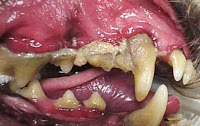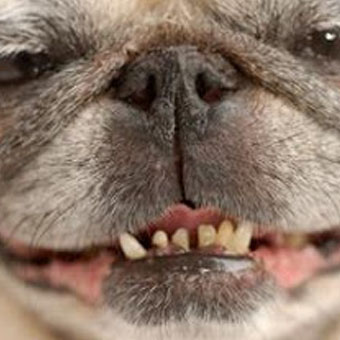Does your dog’s breath cause you to gag and turn away? Are your pet’s kisses unwelcome due to fetid breath? Many dog owners recognize that distinctive smell which is often accepted as a condition of dog ownership. But stinky dog breath, while common, is actually a symptom of illness and should not be ignored. Doggie dragon breath, just like a blinking traffic light, is a sign of danger ahead. Don’t ignore dog breath for what it is- an indicator of oral infection that if left unchecked will impact your dog’s health and shorten his lifespan.
 What’s the big deal about bad breath? It’s more than just the smell. Bad breath, also referred to as halitosis, arises from plaque and oral bacteria. Periodontal disease progresses as plaque accumulates, mineralizes into tartar, and inflammation causes destruction of the supportive tissues around the teeth. Dogs don’t simply get cavities, rather they will lose their teeth as connective attachments deteriorate. Untreated dental infections jeapordize the health of nearby teeth and may lead to osteomyelitis- infection in the bone. And with time, untreated periodontal disease showers the bloodstream with bacterial products leading to other diseases such as liver, kidney and heart disease.
What’s the big deal about bad breath? It’s more than just the smell. Bad breath, also referred to as halitosis, arises from plaque and oral bacteria. Periodontal disease progresses as plaque accumulates, mineralizes into tartar, and inflammation causes destruction of the supportive tissues around the teeth. Dogs don’t simply get cavities, rather they will lose their teeth as connective attachments deteriorate. Untreated dental infections jeapordize the health of nearby teeth and may lead to osteomyelitis- infection in the bone. And with time, untreated periodontal disease showers the bloodstream with bacterial products leading to other diseases such as liver, kidney and heart disease.
Fight Halitosis
 The best way to control periodontal disease is to assume an offensive attack. Monitor your pet’s oral health by flipping up your dog’s lip to discover what is lurking underneath. Look for red inflamed gums, yellow or brown accumulation on the teeth, tooth discoloration, or bad breath. Any are symptoms of periodontal disease and should be addressed with your veterinarian. Have your pet’s teeth cleaned regularly at the veterinary office and follow up with home dental care including daily brushing.
The best way to control periodontal disease is to assume an offensive attack. Monitor your pet’s oral health by flipping up your dog’s lip to discover what is lurking underneath. Look for red inflamed gums, yellow or brown accumulation on the teeth, tooth discoloration, or bad breath. Any are symptoms of periodontal disease and should be addressed with your veterinarian. Have your pet’s teeth cleaned regularly at the veterinary office and follow up with home dental care including daily brushing.
These professional veterinary cleanings are important to safely remove mineralized tartar, clean under the gum line, permit a thorough oral exam and take x-rays. Veterinary dental x-rays are an essential tool in detecting problems and have been shown to identify oral disease in 28% of dogs and 42% of cats that have a outwardly normal mouth.
Don’t fall into the hype about herbal spray-on products or “awake” dental procedures- these only offer a cosmetic improvement in visible tartar, which only covers a small part of the tooth. These methods, often incorrectly touted as a safe alternative to professional cleanings, can’t address the 60% of a dog’s tooth which lies under the gum line- exactly where periodontal disease brews and does its damage.
Once you identify that nasty doggie breath, you can be certain some degree of periodontal disease is present and dental intervention is needed. Statistics show that by 3 years of age 80% of dogs and cats already have periodontal disease. Don’t forget that small and toy breeds of dog have accelerated dental problems diagnosed as young as 1 to 2 years of age.
Think prevention- have your dog’s teeth cleaned and embrace home dental care steps. And the next time you find yourself in a cloud of canine halitosis, you won’t turn the other way- you’ll grab that toothbrush.

